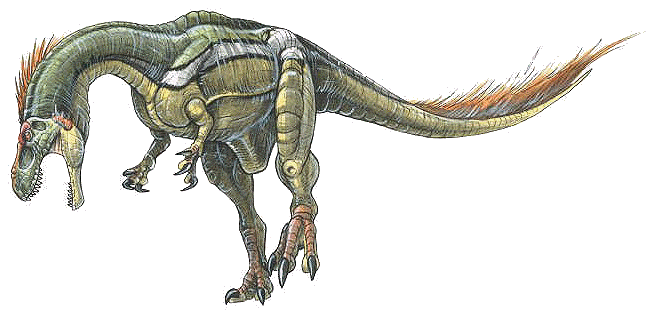Post by Barry the Baryonyx on Jun 26, 2007 0:30:54 GMT -5
Eotyrannus lengi

Eotyrannus ("dawn tyrant") was a tyrannosauroid theropod dinosaur hailing from the Early Cretaceous Wessex Formation beds, included in Wealden Group, located in the southwest coast of the Isle of Wight, United Kingdom. The remains, consisting of assorted skull, axial skeleton and apendicular skeleton elements, from a juvenile or subadult, found in a plant debris clay bed, was described by Hutt et al. in early 2001. The etymology of the generic name refers to the animal’s character as an "early tyrant", while the specific epithet is a mention to the discoverer of the fossil. Eotyrannus is a 6 meter-long theropod whose tyrannosauroid character is given by serrated premaxillary teeth with a D cross section, proportionally elongate tibiae and metatarsals. Primitive characters for Tyrannosauroidea are the elongate neck vertebrae and the long well developed arms forelimbs along with the undecorated dorsal surface of the skull, unlike the more advanced tyrannosaurids. However this animal, proportionally, has one of the longest hands in Theropoda known to date.This theropod would be a probable predator of such herbivorous dinosaur species as Hypsilophodon and Iguanodon. E. lengi’s find corroborates the notion that early tyrannosaurs were gracile with long forelimbs and three-fingered grasping hands though the big size of the animal either means that early evolution for this clade was carried out at a big size or Eotyrannus developed big size independently. The find of this animal in Europe puts interesting questions to the purported Asian origin for these animals along with North American Stokesosaurus and European Aviatyrannis arguing for a more complex biogeography for tyrannosaurs.
Scientific classification
Kingdom: Animalia
Phylum: Chordata
Class: Sauropsida
Superorder: Dinosauria
Order: Saurischia
Suborder: Theropoda
Superfamily: Tyrannosauroidea
Genus: Eotyrannus

Eotyrannus ("dawn tyrant") was a tyrannosauroid theropod dinosaur hailing from the Early Cretaceous Wessex Formation beds, included in Wealden Group, located in the southwest coast of the Isle of Wight, United Kingdom. The remains, consisting of assorted skull, axial skeleton and apendicular skeleton elements, from a juvenile or subadult, found in a plant debris clay bed, was described by Hutt et al. in early 2001. The etymology of the generic name refers to the animal’s character as an "early tyrant", while the specific epithet is a mention to the discoverer of the fossil. Eotyrannus is a 6 meter-long theropod whose tyrannosauroid character is given by serrated premaxillary teeth with a D cross section, proportionally elongate tibiae and metatarsals. Primitive characters for Tyrannosauroidea are the elongate neck vertebrae and the long well developed arms forelimbs along with the undecorated dorsal surface of the skull, unlike the more advanced tyrannosaurids. However this animal, proportionally, has one of the longest hands in Theropoda known to date.This theropod would be a probable predator of such herbivorous dinosaur species as Hypsilophodon and Iguanodon. E. lengi’s find corroborates the notion that early tyrannosaurs were gracile with long forelimbs and three-fingered grasping hands though the big size of the animal either means that early evolution for this clade was carried out at a big size or Eotyrannus developed big size independently. The find of this animal in Europe puts interesting questions to the purported Asian origin for these animals along with North American Stokesosaurus and European Aviatyrannis arguing for a more complex biogeography for tyrannosaurs.
Scientific classification
Kingdom: Animalia
Phylum: Chordata
Class: Sauropsida
Superorder: Dinosauria
Order: Saurischia
Suborder: Theropoda
Superfamily: Tyrannosauroidea
Genus: Eotyrannus


 Is it just us?
Is it just us?